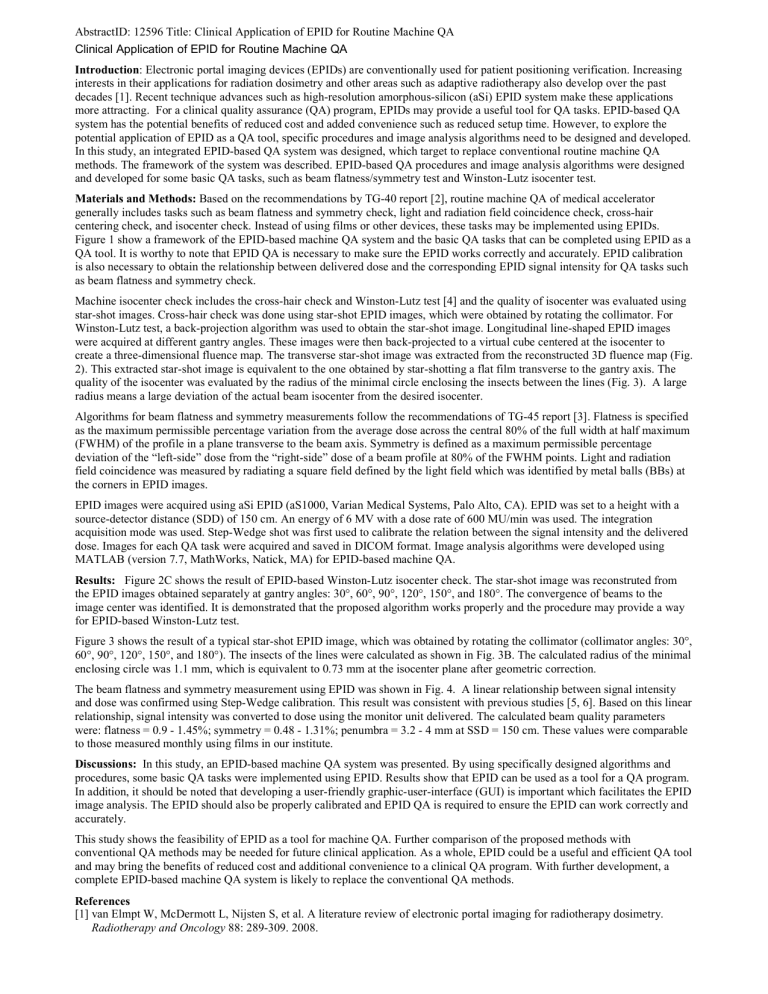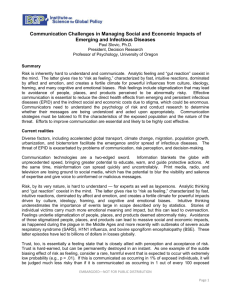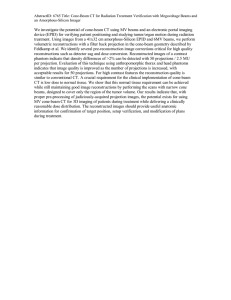AbstractID: 12596 Title: Clinical Application of EPID for Routine Machine... interests in their applications for radiation dosimetry and other areas... Clinical Application of EPID for Routine Machine QA Introduction

AbstractID: 12596 Title: Clinical Application of EPID for Routine Machine QA
Clinical Application of EPID for Routine Machine QA
Introduction: Electronic portal imaging devices (EPIDs) are conventionally used for patient positioning verification. Increasing interests in their applications for radiation dosimetry and other areas such as adaptive radiotherapy also develop over the past decades [1]. Recent technique advances such as high-resolution amorphous-silicon (aSi) EPID system make these applications more attracting. For a clinical quality assurance (QA) program, EPIDs may provide a useful tool for QA tasks. EPID-based QA system has the potential benefits of reduced cost and added convenience such as reduced setup time. However, to explore the potential application of EPID as a QA tool, specific procedures and image analysis algorithms need to be designed and developed.
In this study, an integrated EPID-based QA system was designed, which target to replace conventional routine machine QA methods. The framework of the system was described. EPID-based QA procedures and image analysis algorithms were designed and developed for some basic QA tasks, such as beam flatness/symmetry test and Winston-Lutz isocenter test.
Materials and Methods: Based on the recommendations by TG-40 report [2], routine machine QA of medical accelerator generally includes tasks such as beam flatness and symmetry check, light and radiation field coincidence check, cross-hair centering check, and isocenter check. Instead of using films or other devices, these tasks may be implemented using EPIDs.
Figure 1 show a framework of the EPID-based machine QA system and the basic QA tasks that can be completed using EPID as a
QA tool. It is worthy to note that EPID QA is necessary to make sure the EPID works correctly and accurately. EPID calibration is also necessary to obtain the relationship between delivered dose and the corresponding EPID signal intensity for QA tasks such as beam flatness and symmetry check.
Machine isocenter check includes the cross-hair check and Winston-Lutz test [4] and the quality of isocenter was evaluated using star-shot images. Cross-hair check was done using star-shot EPID images, which were obtained by rotating the collimator. For
Winston-Lutz test, a back-projection algorithm was used to obtain the star-shot image. Longitudinal line-shaped EPID images were acquired at different gantry angles. These images were then back-projected to a virtual cube centered at the isocenter to create a three-dimensional fluence map. The transverse star-shot image was extracted from the reconstructed 3D fluence map (Fig.
2). This extracted star-shot image is equivalent to the one obtained by star-shotting a flat film transverse to the gantry axis. The quality of the isocenter was evaluated by the radius of the minimal circle enclosing the insects between the lines (Fig. 3). A large radius means a large deviation of the actual beam isocenter from the desired isocenter.
Algorithms for beam flatness and symmetry measurements follow the recommendations of TG-45 report [3]. Flatness is specified as the maximum permissible percentage variation from the average dose across the central 80% of the full width at half maximum
(FWHM) of the profile in a plane transverse to the beam axis. Symmetry is defined as a maximum permissible percentage deviation of the “left-side” dose from the “right-side” dose of a beam profile at 80% of the FWHM points. Light and radiation field coincidence was measured by radiating a square field defined by the light field which was identified by metal balls (BBs) at the corners in EPID images.
EPID images were acquired using aSi EPID (aS1000, Varian Medical Systems, Palo Alto, CA). EPID was set to a height with a source-detector distance (SDD) of 150 cm. An energy of 6 MV with a dose rate of 600 MU/min was used. The integration acquisition mode was used. Step-Wedge shot was first used to calibrate the relation between the signal intensity and the delivered dose. Images for each QA task were acquired and saved in DICOM format. Image analysis algorithms were developed using
MATLAB (version 7.7, MathWorks, Natick, MA) for EPID-based machine QA.
Results: Figure 2C shows the result of EPID-based Winston-Lutz isocenter check. The star-shot image was reconstruted from the EPID images obtained separately at gantry angles: 30°, 60°, 90°, 120°, 150°, and 180°. The convergence of beams to the image center was identified. It is demonstrated that the proposed algorithm works properly and the procedure may provide a way for EPID-based Winston-Lutz test.
Figure 3 shows the result of a typical star-shot EPID image, which was obtained by rotating the collimator (collimator angles: 30°,
60°, 90°, 120°, 150°, and 180°). The insects of the lines were calculated as shown in Fig. 3B. The calculated radius of the minimal enclosing circle was 1.1 mm, which is equivalent to 0.73 mm at the isocenter plane after geometric correction.
The beam flatness and symmetry measurement using EPID was shown in Fig. 4. A linear relationship between signal intensity and dose was confirmed using Step-Wedge calibration. This result was consistent with previous studies [5, 6]. Based on this linear relationship, signal intensity was converted to dose using the monitor unit delivered. The calculated beam quality parameters were: flatness = 0.9 - 1.45%; symmetry = 0.48 - 1.31%; penumbra = 3.2 - 4 mm at SSD = 150 cm. These values were comparable to those measured monthly using films in our institute.
Discussions: In this study, an EPID-based machine QA system was presented. By using specifically designed algorithms and procedures, some basic QA tasks were implemented using EPID. Results show that EPID can be used as a tool for a QA program.
In addition, it should be noted that developing a user-friendly graphic-user-interface (GUI) is important which facilitates the EPID image analysis. The EPID should also be properly calibrated and EPID QA is required to ensure the EPID can work correctly and accurately.
This study shows the feasibility of EPID as a tool for machine QA. Further comparison of the proposed methods with conventional QA methods may be needed for future clinical application. As a whole, EPID could be a useful and efficient QA tool and may bring the benefits of reduced cost and additional convenience to a clinical QA program. With further development, a complete EPID-based machine QA system is likely to replace the conventional QA methods.
References
[1] van Elmpt W, McDermott L, Nijsten S, et al. A literature review of electronic portal imaging for radiotherapy dosimetry.
Radiotherapy and Oncology 88: 289-309. 2008.
AbstractID: 12596 Title: Clinical Application of EPID for Routine Machine QA
[2] Kutcher GJ, Coia L, Gillin M, et al. Comprehensive QA for radiation oncology: Report of AAPM radiation therapy committee task group 40. Medical Physics 21:581-618. 1994.
[3] Nath R, Biggs PJ, Bova FJ, et al. AAPM code of practice for radiotherapy accelerators: Reports of AAPM radiation therapy task group No. 45. Medical Physics 21(7): 1093-1211. 1994.
[4] Lutz W, Winston KR, Maleki N. A system for stereotactic radiosurgery with a linear accelerator. International Journal of
Radiation Oncology Biology Physics 14(2): 373-381. 1988
[5] McDermott LN, Louwe RJ, Sonke JJ, van Herk MB, Mijnheer BJ. Dose–response and ghosting effects of an amorphous silicon electronic portal imaging device. Medical Physics 31:285–95. 2004.
[6] Antonuk LE, El-Mohri Y, Huang W, et al. Initial performance evaluation of an indirect-detection, active matrix flat-panel imager (AMFPI) prototype for megavoltage imaging. International Journal of Radiation Oncology Biology Physics 42:437–
54. 1998.
Figure 1: Framework of an EPID-based machine QA system.
(A) (B) (C)
Figure 2: An illustration of EPID-based Winston-Lutz test. Line-shaped EPID images were acquired at different gantry angles (A). These images were used to reconstruct the 3D fluence map at the isocenter (B). The transverse star-shot image for Winston-Lutz test was derived from the reconstructed 3D map (C).
(A) (B)
Figure 3: Star-shot isocenter check. Star-shot EPID images were acquired by rotating the collimator (A). The radius of the minimal circle enclosing the insects between the lines was calculated to determine the quality of the isocenter (B).
Figure 4: EPID-based beam flatness and symmetry measurement. Images were acquired using Varian aS1000 EPID system
(Source-detector-distance: 150cm; field size: 15 cm x15 cm; 100 MU).



![INITIAL ENTRY [headstart - fourth (4) grade]](http://s3.studylib.net/store/data/007186926_1-bbcbbac65c6b7e51aa650c936c0e7792-300x300.png)


